Orrery Model
From DT Online
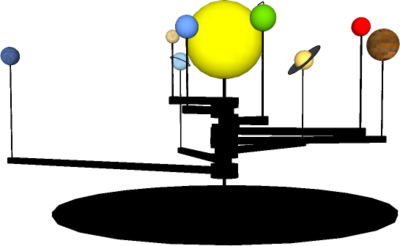
Introduction
Models of our Solar System are used to help us understand the arrangement and movements of Planets around the Sun. A Planetarium usually refers to large model which can be projected on to a dome-shaped screens or the ceilings of a purpose built theatre given this name. Smaller, table-top size models are often referred to as Orreries, named after the 4th Earl of Orrery who was presented with a very sophisticated mechanical model made by a clockmaker during the early 18th century.
Very simple models can be made using just paper and card and more complex moving models created using construction kits. Stripwood tools and techniques can also be used to construct Orreries of varying degrees of complexity.
Preparing the Materials
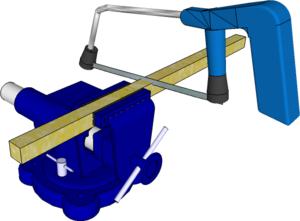
The Orrery described is made using the following materials:
- 10mm square [Stripwood Technology Materials|Stripwood] (other small sizes could be used or Balsawood or even strips of plastics);
- 50mm diameter discs of [Stripwood Technology Materials|MDF or plywood] (the diameter can be varied, and they don't have to be circular, but it s useful if they are pre-drilled in the centre);
- 6mm dowel for the main Sun axis (a metal rod, tube or threaded studding could also be used - and would be stronger);
- 6mm repair washers to space out the strips holding the Planets (not essential but it helps the arms to move more freely);
- BBQ skewers to support the Planets (thin wire could also be used and could be bent to show the axis of rotation - eg about 22.5deg for the Earth which gives us our Seasons);
- Polystyrene Balls to make the Planets (wooden balls could also be used);
- Wooden base plate (a disc of 6mm ply was used but this can vary - and it doesn't have to be a circle!).
Calculating Sizes and Spacings
The very large sizes of the Planets and their various massive distances from the Sun mean that is is not practicable to make a table-top Orrery completely to scale and compromises have to be made. If one scale is used to show the Planets and another to represent their distance from the Sun, it is possible to give at least some indication of their relative sizes and positions.
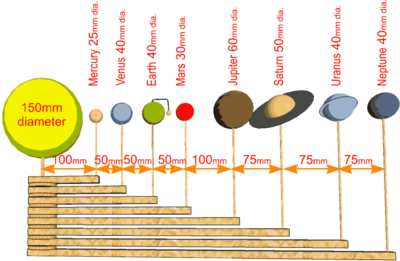
The Planets The starting point for the size of this model is the range of diameters of polystyrene balls, used to make the Planets, when matched against the different diameters of the Planets. This resulted in the following choices: Mercury (25mm), Venus (40mm), Earth (40mm), Mars (30mm), Jupiter (60mm), Saturn (50mm), Uranus (40mm), Neptune (40mm). This serves to give some indication of the sizes of Planets relative to each other (e.g.: Mercury is the smallest, Jupiter the largest, Earth and Venus are about the same size and Mars a little smaller).
Orbits
The distances between orbits will need to be sufficient to enable Planets to pass by each other. If all 8 Planets are to be included then perhaps allowance should be made for a greater spacing between the Inner Planets and Outer Planets to indicate space for the Asteroid Belt? A further consideration is to ensure that the size of the model overall does not become excessive. The sizes shown produce a model in which the longest support arm is approximately 600mm:
The Sun
The Sun is so massive that it cannot fit in with any sensible scale (it is more than 100 times bigger than Earth) but it can be represented either by a larger polystyrene ball (e.g. 150mm dia), a ball of any size but painted yellow or gold perhaps, or even a torch bulb (this would help show night and day or eclipses) . If a torch bulb is to be used it can either be self-contained with a battery inside a hollow sphere or the axis for the Sun will need to be a tube to allow for the battery wiring required.
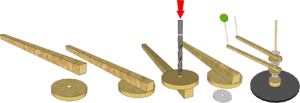
Construction
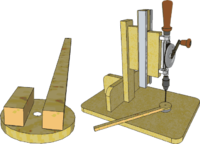
Cut the 8 arms of the Orrery to length and at one end glue each one across the centre of (say) a 50mm disc of 6mm thick MDF or Ply pre-drilled with a hole in the centre. When the glue is set turn the assembly over and use the pre-drilled hole to guide a larger drill through both pieces - the drill size chosen to suit the dowel, rod or tube used for the Sun axis.

Drilling can be made easier for younger children if a Hand Drill Stand as shown is available. Drilling can be avoided if the disc is pre-drilled the right size and the Orrery arms glued off-centre with a packing piece opposite. Alternatively, an adult could complete the drilling.
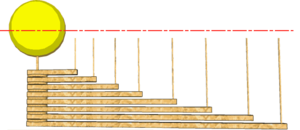
Drilling a small hole at the other end of each arm to receive the Planet supports may be especially difficult because of the very small size of hole required (e.g. 2.5mm or 3mm). Snipping the head off a Panel Pin can make a simple small drill suitable for this task but drilling can be avoided completely as follows:
- a BBQ skewer could be glued to the side of the arm
- a saw cut can be made in the end of the arm
- planet supports can first be fixed to a small, suitably pre-drilled disc, button, bead, or other 'found' object, then glued on.
Alternatively, an adult could complete the drilling.
Aligning the Orbits
When all the Planet supports have been added they can be trimmed to length such that all Planets line up with centre of the Sun

Completing the Model Orrery
Planets are painted and attached to the ends of the Planet supports to complete the Orrery. The NASA Solar System website lists colours that can be used for each, and a card ring can be cut out to put round Saturn. In addition, all the arms and Planet supports can be painted black to help make the coloured Planets stand out.
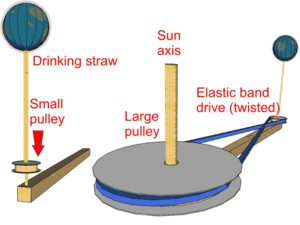
Further Work
- Orreries can be very complex and this is a very simple model in which Planet support arms have to be moved by hand. It is possible however to make the Earth rotate as it is moved round in Orbit by using Pulleys as shown (note the need to twist the elastic band to ensure the correct direction of rotation).
- Try making the Moon from a bead and use Florists Wire or a straightened out paper clip to attach it to the top of Earth.
Questions
- If Pulleys are used as shown, what would happen if both the Pulley on the Sun axis and the Pulley on the Planet support were both the same size?
- If a 'bendy straw' is used and the top bent to hold the Earth at a tilt of 22.5 degrees, how would same size pulleys help understanding of how Seasons occur?
Notes:
- MDF Discs which are pre-drilled are most useful if available, otherwise this might be done as preparation before using with younger children - alternatively a Hand Drill Stand could be used (if neccessary, adults or older children can cut them out of strips of MDF or Ply using a Holesaw).
- Dowels 4mm, 5mm, and 6mm are useful sizes for axles.
- Florist Wire is easily bent into shape whereas stiff wire, such as Brass Brazing Rod, is more suitable for connecting rods.



















